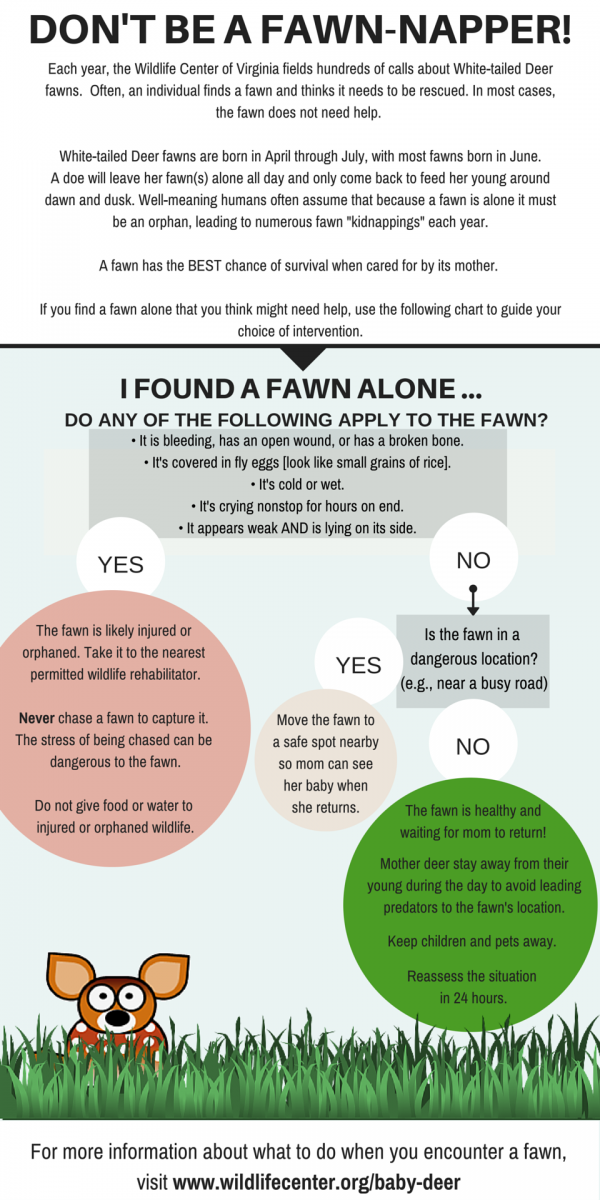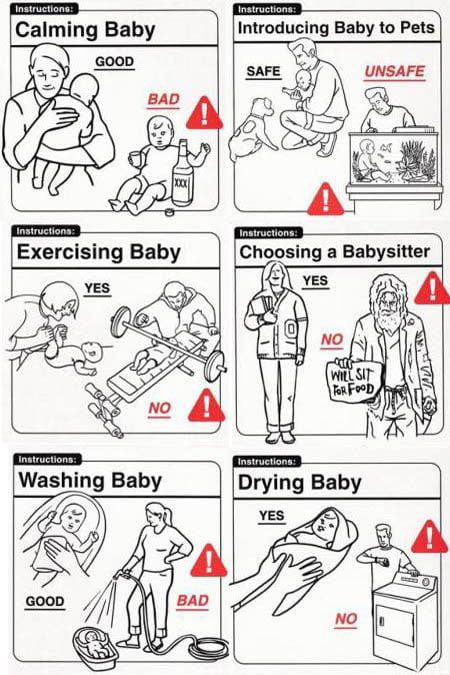What to feed orphaned wild baby rabbits
Caring for Newborn Baby Rabbits
IF THESE ARE WILD BABIES
It’s that time of year again. Wild babies everywhere. But are they at risk?
Wild rabbits hide their nests in plain view, often in the middle of your yard, bushes, etc. If you find a nest that has been disturbed, do the best you can to restore it and leave the babies in there. If a dog discovers the nest, do your best to restore it (with grass, leaves, whatever mama has used), make sure the kits are in there, and find a way to keep the dog(s) away from the nest. Mama will return for her babies and taking them away will seriously decrease their chance of survival. If you do not see the mama—DON’T WORRY—they only nurse their babies a few minutes a day, then they stay away so as to not draw predators to the nest.
If a kit is injured or an animal brings you an injured baby, if you have no choice but to help a baby, please do not try to care or it yourself—-get it to a rabbit vet or a wildlife rehabilitator
- Local wildlife rehabilitator: https://www.
nwrawildlife.org
- List of rabbit vets: http://rabbit.org/vet-listings/
The best thing you can do for wild babies is to leave them alone (restored to the nest) or, if injured, get them to a rabbit vet or wildlife rehabilitator.
DOMESTIC/PET RABBITS
WHERE TO PUT THE BABIES
Make the babies a soft nest area in a box with clean towels. We like to put one folded towel on the bottom and another bunched on top of that, so the babies can snuggle into it. You can also purchase soft nesting wool from a pet store and put that on top of the towel. You can also take whatever nesting material they were in and put it in the box as well. Cover the box almost entirely with a light towel, making sure that there will be enough air so the babies do not suffocate. Leaving about a one inch gap at the top is usually sufficient. Keep the babies in an out-of-the way, QUIET area, such as an adult’s bedroom. If the room temperature is between 68-72 degrees you will not need to provide extra heat, but if it’s cooler than that you will need to provide extra warmth.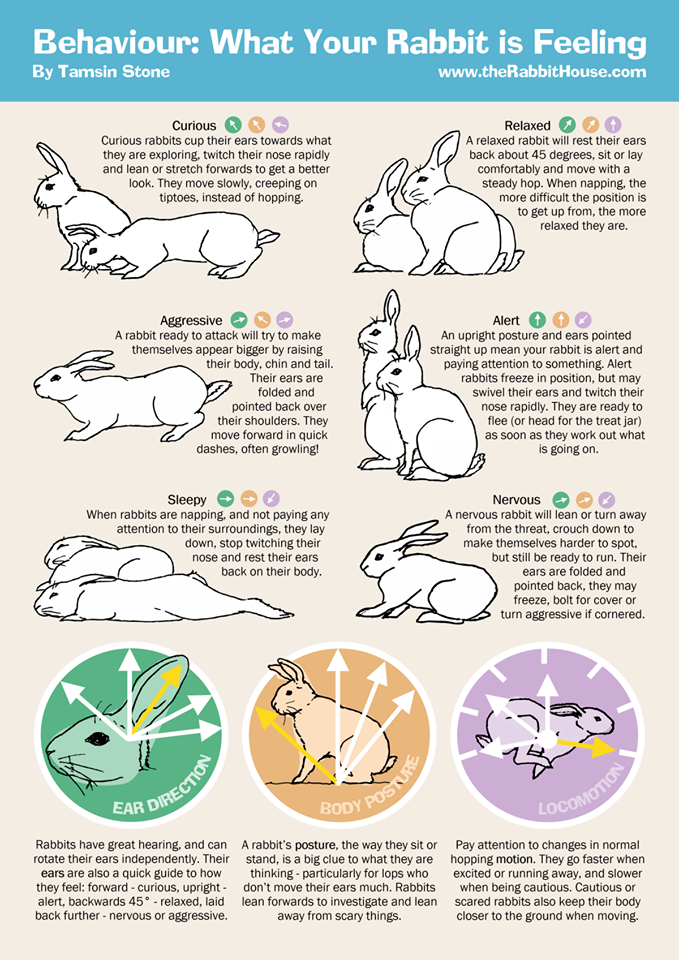 Use a heating pad set on low and slip it under one half only of the box. We do it this way so that the babies can move to a cooler area if it gets too warm. DO NOT put babies directly on heating pad, as babies can burn themselves very badly.
Use a heating pad set on low and slip it under one half only of the box. We do it this way so that the babies can move to a cooler area if it gets too warm. DO NOT put babies directly on heating pad, as babies can burn themselves very badly.
If the babies were with their mamma, but she is not caring for them (and you are sure she is ignoring them) you may need to separate her from them so they will not get hurt. Rabbit milk is very caloric and the kittens (baby rabbits) only nurse for a few minutes a day, so if you think that she is not caring for them based only on the fact you don’t see them feed…think again. If you do think they are being neglected, you can check: Are they cold? Are they making crying sounds for more than a few minutes before (or at) feeding time? Are they blue? Is the skin shriveled? Check for dehydration: gently pinch together the skin at the nape of the neck. If it sticks together or stays in a tent, they are dehydrated. A healthy kit has a round belly, is warm, gains weight on a daily basis, and snuggles with its litter mates. If they are dehydrated, cold, losing weight or becoming injured, of course, something must be done
A healthy kit has a round belly, is warm, gains weight on a daily basis, and snuggles with its litter mates. If they are dehydrated, cold, losing weight or becoming injured, of course, something must be done
WHAT TO FEED THE BABIES
Baby rabbits should be fed Kitten Milk Replacer (KMR) or goat milk, which you can buy at pet stores, or sometimes even a local veterinarian’s office. Because rabbit milk is the most caloric of all mammals, we add in one tablespoon of 100% heavy whipping cream (no sugar) to each can of KMR. Most kits will not nurse from the baby animal bottles you can buy at stores. Instead, use a sterile oral syringe, which can be purchased at most pharmacies. A better alternative are these nipples, which come the a syringe, but you may not be able to find them locally/right away (link).
It is best to feed baby rabbits no more than twice a day, but sometimes it takes more feedings to get an adequate amount into them, especially at first.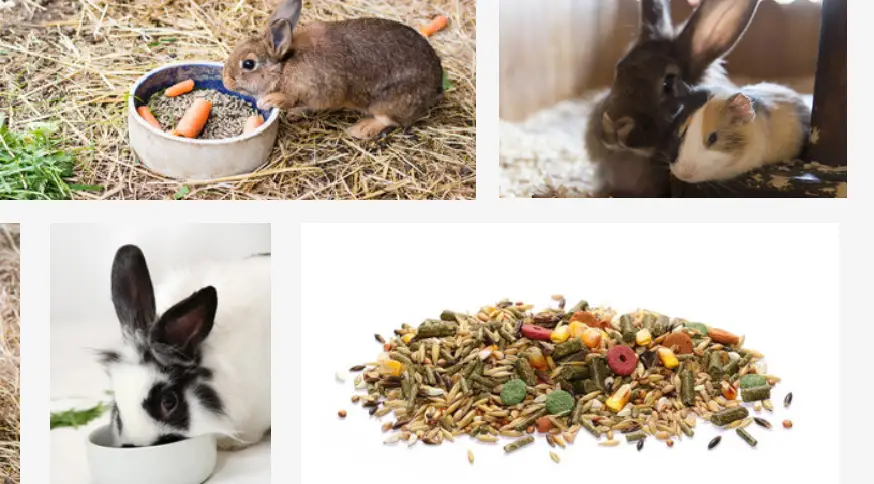
How much to feed varies greatly on what breed of rabbit you are feeding, and how big the kit is, but here is a basic guideline for the daily amount to feed a domestic rabbit who will be approximately 5-6 pounds as an adult (average rabbit size). You can increase the amounts as needed for larger breeds.
To help the kits maintain healthy gut bacteria, go to your local health food store (and get a bottle of ACIDOPHILUS. Ask for the capsules that have the “grainy stuff” inside (they are easier to mix than the “powdery stuff”) and add a bit to the formula at each feeding.
ALL amounts below should be divided into two feedings per day.
- Newborn – 1 week
- 4-5 cc formula
- 1-2 weeks
- 10-15 cc formula
- 2-3 weeks
- 15-30 cc formula
- 3-6 weeks, until weaned
- 30 cc formula
HOW DO I DO THIS?
Baby rabbits feed from their mothers while lying on their backs.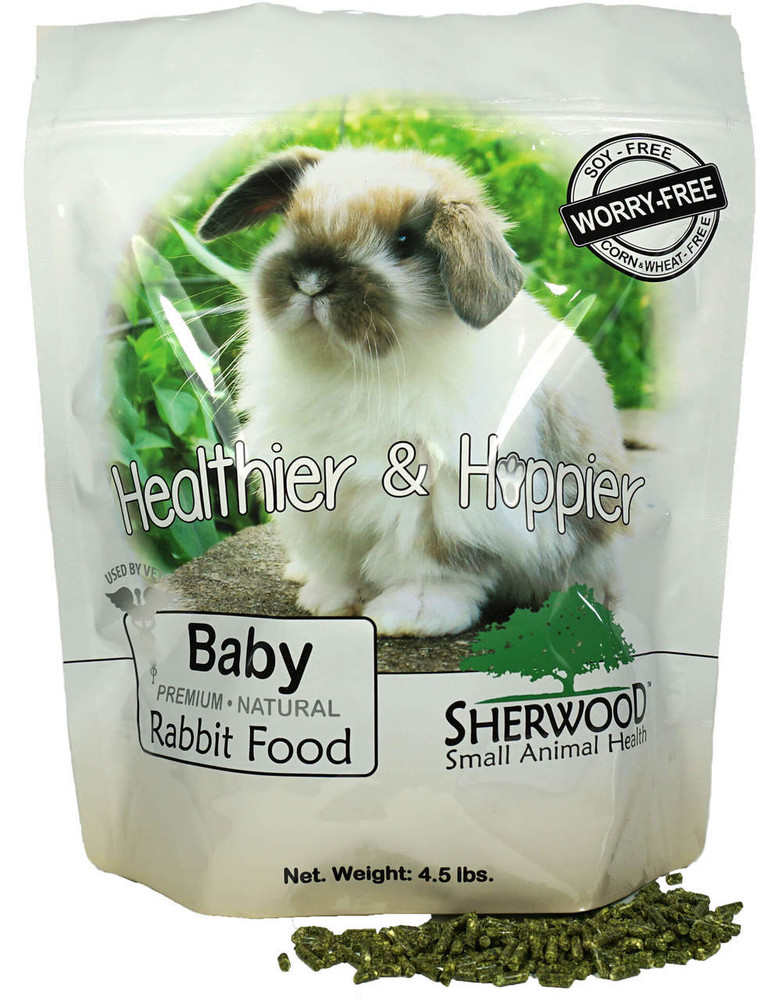 You may loosely wrap baby in a soft face cloth or hand towel and lay it on your lap or in the crook of your arm. If bunny will NOT eat this way, of course, do the best you can. It is ABSOLUTELY CRUCIAL to let the baby eat at it’s own pace—especially if it is not suckling from the syringe willingly. If you squirt the liquid in too quickly you can aspirate (get liquid in) the lungs and the rabbit will suffocate.
You may loosely wrap baby in a soft face cloth or hand towel and lay it on your lap or in the crook of your arm. If bunny will NOT eat this way, of course, do the best you can. It is ABSOLUTELY CRUCIAL to let the baby eat at it’s own pace—especially if it is not suckling from the syringe willingly. If you squirt the liquid in too quickly you can aspirate (get liquid in) the lungs and the rabbit will suffocate.
Until their eyes open (10 days): After each feeding it is important to make the bunny defecate and urinate to keep the intestinal tract and urinary system running smoothly. Use a soft cloth or a cotton ball moistened with warm water and gently stroke the genital area until the bunny starts producing stool and urine. Keep stroking until the bunny stops. You are replicating the behavior of the mother rabbit who would lick her young to stimulate them to go to the bathroom. The stool will be soft and may be varying shades of green and yellow. If the urine is brown and gritty, the buns are not adequately hydrated and you need to get them to a rabbit vet ASAP—-it is an emergency. Be sure to clean baby’s mouth with a damp cloth or paper towel, so that no milk dries in the hair.
If the urine is brown and gritty, the buns are not adequately hydrated and you need to get them to a rabbit vet ASAP—-it is an emergency. Be sure to clean baby’s mouth with a damp cloth or paper towel, so that no milk dries in the hair.
Baby rabbit eyes open at about 10 days of age. You may start introducing them to hay and pellets at this point, but no veggies or fruits yet. Just leave some timothy or orchard and alfalfa hay and pellets in a corner of the box where the babies can easily get to them. Make sure it the pellets are plain, high fiber and fresh, with no added goodies such as dried banana chips or seeds. Don’t ever leave a deep water dish in which a baby could drown; instead, use something shallow and rinse and fill it frequently.
If you have any questions, please contact us.
Caring For Orphan Baby Rabbits
Wild Baby Bunnies – Orphaned or Not?
Wild baby bunnies are most often not orphaned! Many people mean well when they contact HRS after discovering an “abandoned” nest of wild rabbits. Often they wish to “rehabilitate” them with some advice from others. The reality is fewer than 10% of orphaned rabbits survive a week, and the care that people attempt to provide can be illegal, unnecessary, and potentially harmful.
Often they wish to “rehabilitate” them with some advice from others. The reality is fewer than 10% of orphaned rabbits survive a week, and the care that people attempt to provide can be illegal, unnecessary, and potentially harmful.
The best thing you can do is put the bunny right back where you found him, in the general area, as the mom will only come back at night to call and find him. Leave the area. If injured, please contact a wildlife rehabber or rabbit vet immediately! You can search Google for your state/country and wildlife rehabber. Also search your state + wild rabbit rehabbers. You can call your Humane Society for referral and also check here: http://www.owra.org/find-a-wildlife-rehabilitator If you find a baby with eyes open, and he appears healthy, leave him be.
I/My Dog/My Cat Found a Rabbit Nest! What Do I Do?
Rabbits hide their nests in plain view, often putting them in the open, sometimes in the middle of the lawn, as well as in brush piles and long grass.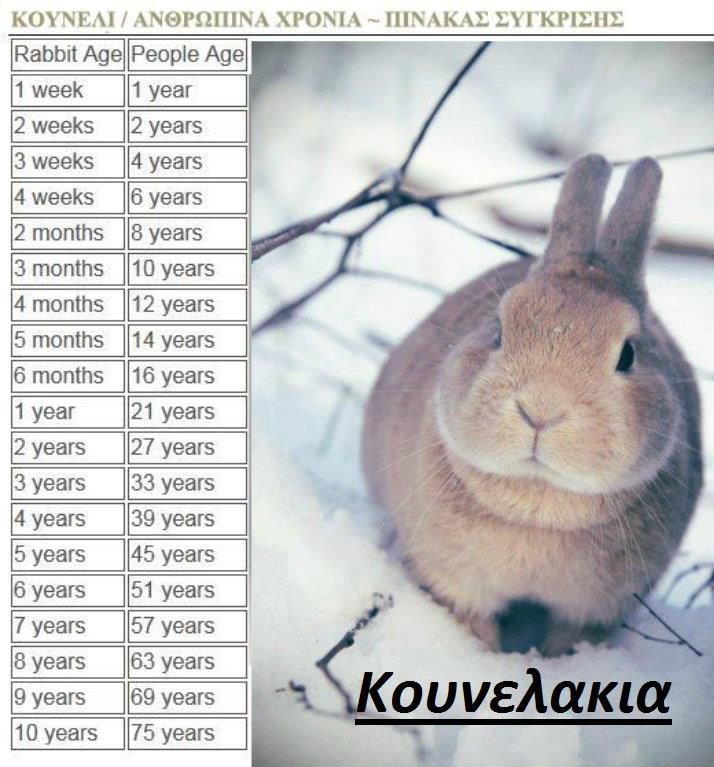 If you find a nest that has been disturbed, do all you can to restore and protect it. Do NOT bring it inside. If a dog has discovered the nest, keep your dog away from the area and reconstruct the nest with grasses. If need be, you can move the nest a few feet away where safer, even up to 5-6 feet away. A moved nest should always be covered with string in a tic tac toe pattern and monitored to be sure the mother found it and came back to the babies. She will scrabble away the surface area to feed her babies beneath her and then scrabble the earth, grass, leaves, back over the nest to hide it again so it’s pretty easy to see if the string has been disturbed and if the babies are warm.
If you find a nest that has been disturbed, do all you can to restore and protect it. Do NOT bring it inside. If a dog has discovered the nest, keep your dog away from the area and reconstruct the nest with grasses. If need be, you can move the nest a few feet away where safer, even up to 5-6 feet away. A moved nest should always be covered with string in a tic tac toe pattern and monitored to be sure the mother found it and came back to the babies. She will scrabble away the surface area to feed her babies beneath her and then scrabble the earth, grass, leaves, back over the nest to hide it again so it’s pretty easy to see if the string has been disturbed and if the babies are warm.
Baby jackrabbits wait like this for momBabies should never be put back into a nest that has been flooded with water, has bugs/ants visibly crawling in and out, or if a baby has been killed and there is blood in the nest. Use common sense. Baby bunnies who have fleas are compromised and should be immediately taken to a wildlife rehabber or humane society, rabbit vet.

Rabbit mothers nurse their babies for approximately 5 minutes a day. Both wild and domestic mothers will be in the nest early in the morning and then again in the evening. The milk is very rich and the babies “fill up” to capacity within minutes. Mother rabbits do not “sit” on the babies to keep them warm as do some mammals and birds. They build a nest with fur and grasses which helps to keep the babies warm in between feedings. For domestic/pet rabbits, do not force a mother rabbit to sit in the nest box. You can pick up the babies and see if they are feeding by checking the size of their stomachs (should not be sunken in), the pinkness of their skin and activity level (they should not be blue in color or sluggish in movement) and the amount of time that you hear them crying (baby bunnies should be quiet most of the day….if they are crying constantly then they are not getting fed). If you come across a nest of wild bunnies, and the mother is nowhere to be seen, please DO NOT disturb them.
If your dog disturbs a nest, or you find a wild bunny with his eyes open, please put him back if not injured. Mom will be coming back at night to call and feed him only once in the middle of the night. Do not take the bunny inside or feed him! IT IS A MATTER OF HIS/HER SURVIVAL AND UP TO US AS HUMANS TO LEAVE NATURE BE AND LET THE MOM CARE FOR HER YOUNG. We often hear of mothers moving their babies and their nests, and have seen moms come back every night for up to a week to look for her missing baby. Do not take the baby from the mom or she will be frantic. Many call or write saying, “… but it is raining, etc., ” but remember, these are wild bunnies and belong out there.
I/My Dog/My Cat Destroyed a Wild Rabbit Nest! What Do I Do?
Remake the nest as best you can with grasses, hay, straw in the same place. Nests can be moved to a safer place up to 10′ away from the original site and can be reconstructed if necessary. To make a new nest, dig a shallow hole about 3″ deep and put into it as much of the original material as you can recover, including the mother’s fur.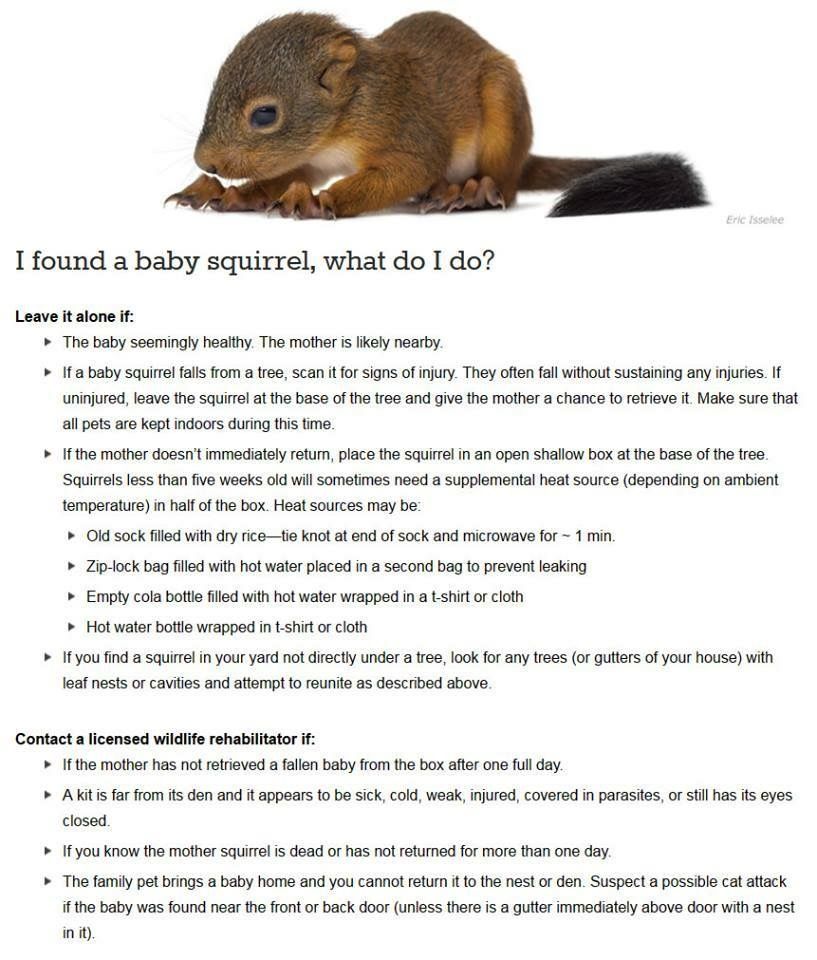 Add dried grass as needed, and put the young back. Mother rabbits return to the nest to nurse only at night, staying away as much as possible so as not to attract predators. To determine if the mother is returning, create a tic-tac-toe pattern over the nest with straw, grasses or tiny twigs. Wait 24 hours to see if the twigs have been disturbed. She may be able to feed them without moving the twigs much, so double check–If the babies look healthy, are warm, then the mother is coming back. If they are cold, dehydrated, get them to a professional; do not care for them yourself. Please contact a Wildlife Rehabber or rabbit vet or Humane Society immediately. Google your state and wildlife rehabbers. Also check http://www.humanesociety.org/animals/resources/tips/find-a-wildlife-rehabilitator.html and http://www.owra.org/find-a-wildlife-rehabilitator
Add dried grass as needed, and put the young back. Mother rabbits return to the nest to nurse only at night, staying away as much as possible so as not to attract predators. To determine if the mother is returning, create a tic-tac-toe pattern over the nest with straw, grasses or tiny twigs. Wait 24 hours to see if the twigs have been disturbed. She may be able to feed them without moving the twigs much, so double check–If the babies look healthy, are warm, then the mother is coming back. If they are cold, dehydrated, get them to a professional; do not care for them yourself. Please contact a Wildlife Rehabber or rabbit vet or Humane Society immediately. Google your state and wildlife rehabbers. Also check http://www.humanesociety.org/animals/resources/tips/find-a-wildlife-rehabilitator.html and http://www.owra.org/find-a-wildlife-rehabilitator
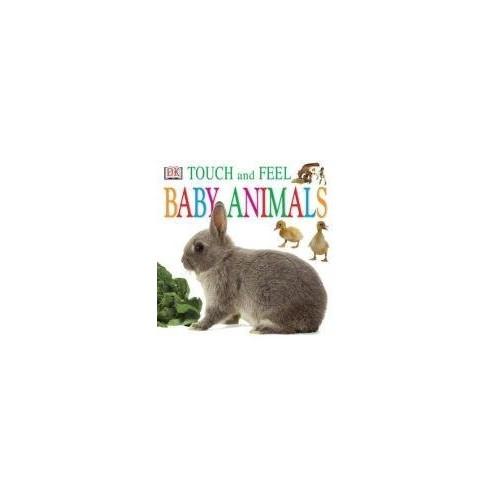
How Do I Know If the Wild Baby Bunnies Need Help?
Very young wild baby bunnies with eyes closed and ears back rarely survive in captivity, even given the most expert human care; and so it is very important to determine whether they really need help. Try to assess whether the infants seem warm and healthy or cold, thin, and dehydrated. One test for dehydration is to gently pinch the loose skin at the back of the neck. If it does not spring back in one second, or stays in a “tent,” the bunny is SEVERELY dehydrated and needs rehabilitation IMMEDIATELY by a professional rabbit vet or rehabber. Another test is to stroke the genital area to stimulate elimination if the eyes are closed. If the pee is brown and gritty, the mother rabbit has not been there to help the bunnies urinate. The brown, gritty urine is toxic, and the infant bunny must be cared for by a professional. Please contact a Wildlife Rehabber or rabbit vet immediately.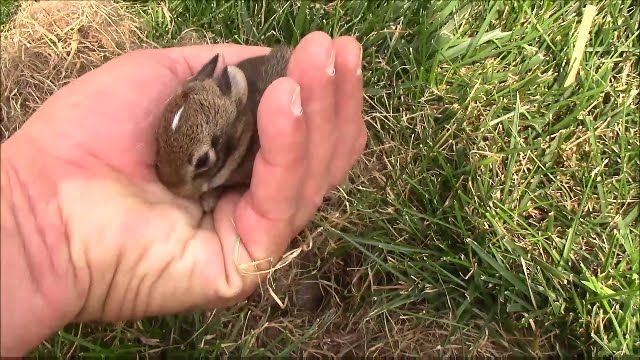 Google your state and wildlife rehabber, call your Humane Society, and also check http://www.humanesociety.org/animals/resources/tips/find-a-wildlife-rehabilitator.html and http://www.owra.org/find-a-wildlife-rehabilitator.
Google your state and wildlife rehabber, call your Humane Society, and also check http://www.humanesociety.org/animals/resources/tips/find-a-wildlife-rehabilitator.html and http://www.owra.org/find-a-wildlife-rehabilitator.
Older baby bunnies who are found outside of the nest may not be orphaned or in need of assistance. This is most often the case. Baby cottontails are born without fur but develop a full coat in a week. Their eyes open in 10 days, and in three to four weeks they are weaned. At this age, they may explore the world outside of the nest but return there to sleep. They are not ignored by the mother but stay with the family group until four or five weeks of age. To determine whether a bunny of this age needs assistance, first see if the bunny feels cold to the touch; perform the dehydration test. Also look for bleeding, convulsing, fly larvae, broken limbs; if any, get to a rabbit vet or emergency vet immediately. If he is just out and about, leave him be.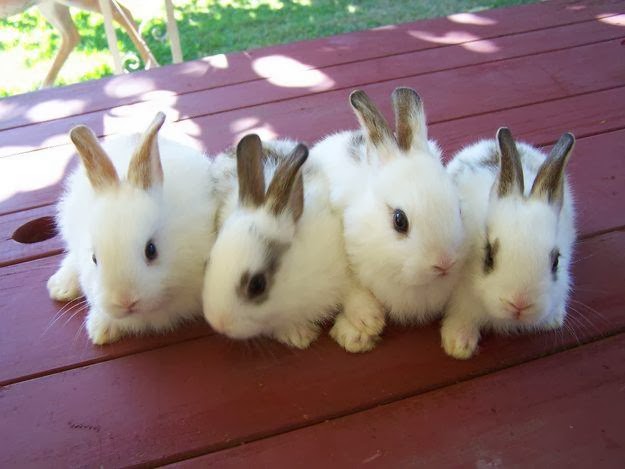.jpg) He is discovering his world, waiting for mom to return at night when we humans are asleep. Don’t assume because he is letting you pick him up, he needs help. They are prey animals, taught to freeze when a predator (or human) approaches. Leave him be!
He is discovering his world, waiting for mom to return at night when we humans are asleep. Don’t assume because he is letting you pick him up, he needs help. They are prey animals, taught to freeze when a predator (or human) approaches. Leave him be!
What if the Baby Bunny is Injured?
Either call or take him to your local rabbit vet, humane society or animal shelter/animal control. Call first as often they will come pick up the baby. If after hours, contact a local emergency rabbit vet or rabbit vets found here and also here. The best thing you can do for an injured wild baby bunny is to get in touch with a skilled Wildlife Rehabber by searching your state/country and wildlife rehabber, or calling your Humane Society, and or trying this link http://www.humanesociety.org/animals/resources/tips/find-a-wildlife-rehabilitator.html and http://www.owra.org/find-a-wildlife-rehabilitator
Is there anything I can do to avoid orphaning wild baby bunnies?
The harsh reality is that many of us who care about wild baby bunnies may be contributing to the suffering and death. House cats who roam outside will kill about every other time they go out. And unlike feral cats who hunt because they are hungry, and kill immediately, house cats maul and torment their prey, sometimes skinning baby bunnies alive. Cat owners need to provide managed outdoor habitats for their cats – such as window boxes or pens. Providing a bell on your cat will help warn the wildlife if you cannot keep him inside. Keep your dogs on a leash with you if you see a rabbit nest.
House cats who roam outside will kill about every other time they go out. And unlike feral cats who hunt because they are hungry, and kill immediately, house cats maul and torment their prey, sometimes skinning baby bunnies alive. Cat owners need to provide managed outdoor habitats for their cats – such as window boxes or pens. Providing a bell on your cat will help warn the wildlife if you cannot keep him inside. Keep your dogs on a leash with you if you see a rabbit nest.
Lawn chemicals can produce convulsing death in baby rabbits. According to the Poison Control Center for Animals, lawn applications that contain herbicides are not directly toxic to small animals; but they may make toxic plants more palatable to them and may make the animals sick for a few days. Products which contain insecticides, such as Dursban or Diazinion, which are added to many lawn products to control fleas or grubs in the lawn, are toxic.
The Bunny is
Wild and Really Orphaned – How do I care for it?Again, make sure you KNOW for sure the mom was killed and the bunnies are abandoned (not warm, etc. ). You will not see the mom. The mom will only come back in the middle of the night to feed her babies. If the mom was killed, the best thing you can do for a wild orphaned baby bunny is to get in touch with a skilled rehabilitator. In the meantime, call your local humane society or animal control and one of these vets for a wildlife referral: Rabbit Vets and Pet Bunny Vets. Google your state and wildlife rehabbers, and also try http://www.humanesociety.org/animals/resources/tips/find-a-wildlife-rehabilitator.html and http://www.owra.org/find-a-wildlife-rehabilitator
). You will not see the mom. The mom will only come back in the middle of the night to feed her babies. If the mom was killed, the best thing you can do for a wild orphaned baby bunny is to get in touch with a skilled rehabilitator. In the meantime, call your local humane society or animal control and one of these vets for a wildlife referral: Rabbit Vets and Pet Bunny Vets. Google your state and wildlife rehabbers, and also try http://www.humanesociety.org/animals/resources/tips/find-a-wildlife-rehabilitator.html and http://www.owra.org/find-a-wildlife-rehabilitator
How much formula should I feed a Wild Orphaned Bunny until I get him/her to a rehabber?
The following is a guideline for the daily amount to feed a TRULY orphaned wild bunny (mother was killed, etc.) Remember with wild bunnies, the mom only comes back at night to call and feed him once or so for 5 mins; please put him back for her if just found and healthy. She leaves them alone between feedings. Don’t assume they are abandoned! Wild rabbits NEED a skilled wildlife rehabber. You should not feed at home or the chances of their surviving is extremely low! Most die from bloat, wrong feedings/stress. These feedings are NOT meant to take place of an actual rehabber, but for someone only who may live too far from a rehabber and is faced with a wild mother, killed, for example. All others need to call your humane society, local rabbit vet, or google your state and wildlife rehabber. You can also check here http://www.humanesociety.org/animals/resources/tips/find-a-wildlife-rehabilitator.html and http://www.owra.org/find-a-wildlife-rehabilitator
Don’t assume they are abandoned! Wild rabbits NEED a skilled wildlife rehabber. You should not feed at home or the chances of their surviving is extremely low! Most die from bloat, wrong feedings/stress. These feedings are NOT meant to take place of an actual rehabber, but for someone only who may live too far from a rehabber and is faced with a wild mother, killed, for example. All others need to call your humane society, local rabbit vet, or google your state and wildlife rehabber. You can also check here http://www.humanesociety.org/animals/resources/tips/find-a-wildlife-rehabilitator.html and http://www.owra.org/find-a-wildlife-rehabilitator
Age + Amount (This WILL vary SO MUCH depending on type of rabbit. It is impossible over the Internet to see your particular rabbit, so this is only approximate.) Use KMR kitten or KMR kitten plus Goat milk, regular not low fat. Add a pinch of acidophilus (aka Probiotic) to the formula to promote healthy gut flora. Formulas vary depending on region. Avoid Esbilac and any puppy formulas! FEED TWICE A DAY ONLY for healthy babies, three times if low weight. It may be easiest to start with a 3 cc/ml syringe or an eyedropper. Feed only with the bunny sitting UPRIGHT, and point syringe down towards bottom or side of mouth, so if too much comes out, the baby does not aspirate. At first, they may only take a few drops at one feeding until they are not stressed and used to this.
Formulas vary depending on region. Avoid Esbilac and any puppy formulas! FEED TWICE A DAY ONLY for healthy babies, three times if low weight. It may be easiest to start with a 3 cc/ml syringe or an eyedropper. Feed only with the bunny sitting UPRIGHT, and point syringe down towards bottom or side of mouth, so if too much comes out, the baby does not aspirate. At first, they may only take a few drops at one feeding until they are not stressed and used to this.
Newborn to One Week: 2- 2+1/2 cc/ml each feeding (two feedings per day).
1-2 weeks: 5-7 cc/ml each feeding (two feedings per day). (depending on bunny..may be much LESS if smaller rabbit!) Newborn babies (if eyes closed) all need to be stimulated to urinate and defecate prior to or following feeding until their eyes open. (Except Jackrabbits do not). *See how to below.
2-3 weeks: 7-13 cc/ml each feeding (two feedings). Domestic eyes open at about 10 days of age. Start introducing them to timothy and oat hay, pellets and water (always add fresh greens for wild ones).
Start introducing them to timothy and oat hay, pellets and water (always add fresh greens for wild ones).
3-6 weeks: 13-15 cc/ml each feeding (two feedings–again, may be LESS depending on size of rabbit! A cottontail/brush bunny will take so much less!! Half this at most.) Cottontails wean and release about 3-4 weeks and jackrabbits much later (9+ weeks), whereas domestic rabbits are 6 weeks.
6 weeks-9weeks for Jackrabbits only, continue up to 9 weeks with formula, gradually changing to a dish for the warm formula, replacing the formula after 9 weeks slowly, continue adding more of their natural greens and hay (dandelions, oat hay, timothy hay, Italian parsley, carrot tops, small carrots cut up) and a small water bowl. Most markets will sell these greens. They need a rehabber before release!
Wild rabbits NEED a skilled wildlife rehabber. These feedings are NOT meant to take place of an actual rehabber, but for someone who may live too far from a rehabber and is faced with a wild mother, killed, for example. Please call your humane society for referrals to rehabbers, or your rabbit vets, or google your state or country and wildlife rehabbers. You can also try here: http://www.humanesociety.org/animals/resources/tips/find-a-wildlife-rehabilitator.html and by state here: http://www.owra.org/find-a-wildlife-rehabilitator or http://www.owra.org/find-a-wildlife-rehabilitator
Please call your humane society for referrals to rehabbers, or your rabbit vets, or google your state or country and wildlife rehabbers. You can also try here: http://www.humanesociety.org/animals/resources/tips/find-a-wildlife-rehabilitator.html and by state here: http://www.owra.org/find-a-wildlife-rehabilitator or http://www.owra.org/find-a-wildlife-rehabilitator
*After each feeding it is important to gently make the bunny defecate and or urinate (brush bunnies/cottontails only..if the eyes are not opened yet) to keep the intestinal and urinary system running smoothly (just UNTIL their eyes open). No need to do this for jackrabbits; they go on their own. Use a cotton ball moistened with warm water after eating, and gently stroke the anal area until the bunny starts producing stool and urine and keep stroking until the bunny stops. You are reproducing the behavior of the mother rabbit who would lick her young to stimulate them to go to the bathroom and to keep the nest clean.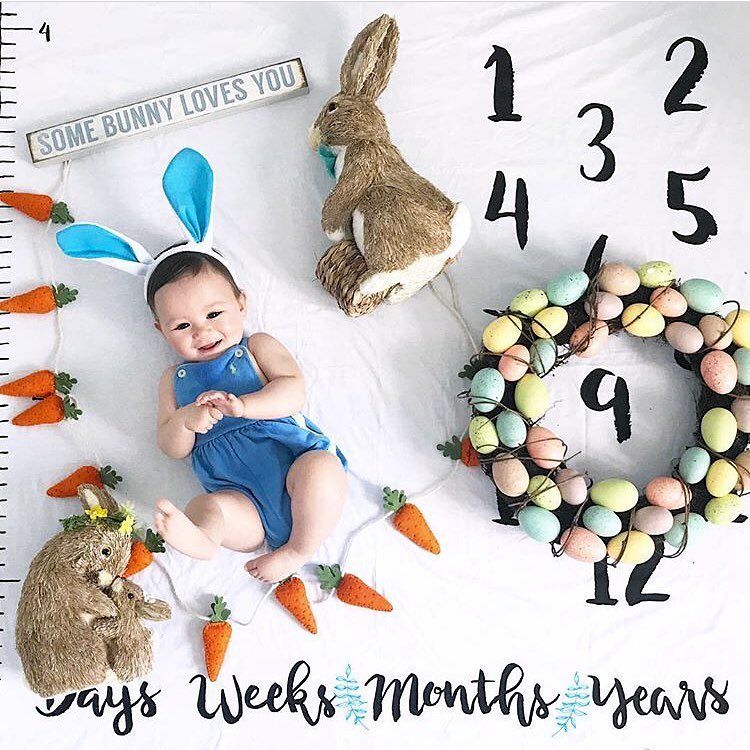 Again, ONLY if the eyes are still closed. Handle a wild rabbit only during feedings as excessive handling can be extremely stressful/potentially fatal. Wild rabbits don’t need heat if furred and healthy. Wild rabbits should not be fed at home, but get them to a professional rehabber as it IS CRITICAL for their survival and to be with their own kind. Most die from overfeeding and/or stress.
Again, ONLY if the eyes are still closed. Handle a wild rabbit only during feedings as excessive handling can be extremely stressful/potentially fatal. Wild rabbits don’t need heat if furred and healthy. Wild rabbits should not be fed at home, but get them to a professional rehabber as it IS CRITICAL for their survival and to be with their own kind. Most die from overfeeding and/or stress.
As soon as the wild bunnies’ eyes are open, you may introduce them to plain alfalfa pellets, hay, such as oat hay, timothy, alfalfa and veggies such as carrot tops, Italian parsley, dandelion greens. Dandelion greens and hay (timothy and oat hay) are extremely important for wild rabbits. You can add whole oats from a feed store, and some grated carrots. The greens must be fresh, rinsed, and replaced if not eaten in a few hours. You can place them in a cup of cold water with just the tops sticking out to keep them fresher. (For a domestic rabbit baby, see section under the Domestic heading).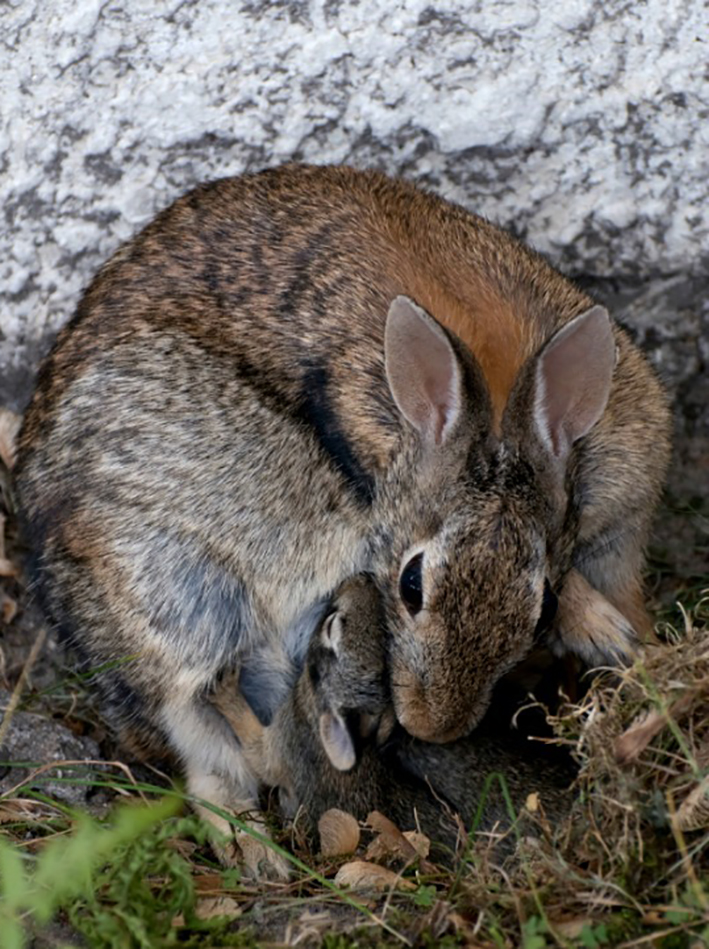 Wild cottontail and brush bunny rabbits should be released as soon as they are eating hay and greens and are approximately 5 inches in body length and run from you. This varies with the area, so size is not easy to say. They will be small, but the longer you keep them, the more agitated and difficult to handle they will become and the less likely their chances for survival in the wild. Release ONLY at dusk or dawn. Jackrabbits (hares) are not ready until 9+ weeks.Make sure they get exercise daily. Jackrabbits mature much slower than the brush/cottontails and need to develop strength. If they are ready, earlier, they will let you know.
Wild cottontail and brush bunny rabbits should be released as soon as they are eating hay and greens and are approximately 5 inches in body length and run from you. This varies with the area, so size is not easy to say. They will be small, but the longer you keep them, the more agitated and difficult to handle they will become and the less likely their chances for survival in the wild. Release ONLY at dusk or dawn. Jackrabbits (hares) are not ready until 9+ weeks.Make sure they get exercise daily. Jackrabbits mature much slower than the brush/cottontails and need to develop strength. If they are ready, earlier, they will let you know.
WARNING: Jackrabbits really NEED a skilled wildlife rehabber as they can run from you, throw themselves into walls to get away; many have died or severely injured themselves in captivity as they are so very wild. Please DO NOT raise them if you are not a skilled wildlife rehabber. This is vital. Noises and sounds easily frighten the jackrabbit and they are not able to be handled after 9 weeks. Often, sadly, we get reports of how a well-meaning person who tried to raise a wild rabbit, only to find it literally died of fright or got injured inside the cage. They are wild and belong with their own kind, out in the wild.
Often, sadly, we get reports of how a well-meaning person who tried to raise a wild rabbit, only to find it literally died of fright or got injured inside the cage. They are wild and belong with their own kind, out in the wild.
Jackrabbits really enjoy being raised together, whereas cottontails/brush bunnies may fight and do fine alone. Give them a carrier as their place of privacy (line with thick towels) with plenty of fresh hay and greens described above and water bowl. Again, wild rabbits need a skilled wildlife rehabber; it is critical to their survival.
The Bunny is DOMESTIC (i.e., pet rabbit, NOT wild) and Really Orphaned – How do I care for a domestic baby?
Baby Domestic Agouti Bunny Baby Domestic/Pet Agouti rabbit babyRemember that both the domestic pet rabbit and wild bunny moms only feed their young usually once in the middle of the night. Don’t assume the mom is not caring for them if you don’t see her nurse them. Check their tummies to see if they are round and the babies are warm in the morning–this means she is caring for them. In the rare situation that you have an orphaned domestic bunny, such as when a domestic rabbit mom is sick or refuses to care for her young, you will need to feed the babies. Overfeeding is a leading cause of death in these youngsters which results in fatal intestinal disease.
In the rare situation that you have an orphaned domestic bunny, such as when a domestic rabbit mom is sick or refuses to care for her young, you will need to feed the babies. Overfeeding is a leading cause of death in these youngsters which results in fatal intestinal disease.
If truly orphaned, use KMR KITTEN powder formula (can also use Meyenberg Regular Goat milk found at Safeway in the milk section or Whole Foods until you can find the KMR KITTEN formula), and follow the directions on the can. It may be easiest to start with a 3 cc/ml syringe or an eyedropper. Some use pet nurser nipples on the end of a luer lock syringe, or a teat cannula on the end of a syringe. Feed only with the bunny sitting UPRIGHT, and point syringe down towards bottom or side of mouth, so if too much comes out, the baby does not aspirate! For those who are slow to learn nursing, SC fluids may be necessary to prevent electrolyte imbalance or dehydration (check with a vet on this only!!). Domestic buns with closed eyes should be fed 2 x a day, and the number of feedings gradually decreased until they are weaned. If their eyes are still closed, you need to stimulate their bottoms with a warm moist towel after feedings to help them to pee. (Domestics are weaned about 6 weeks compared to wild bunnies who are weaned about 3-4 weeks for cottontails and 9+ weeks for jackrabbits). Bloat is commonly associated with too frequent feedings and too much at one time.
If their eyes are still closed, you need to stimulate their bottoms with a warm moist towel after feedings to help them to pee. (Domestics are weaned about 6 weeks compared to wild bunnies who are weaned about 3-4 weeks for cottontails and 9+ weeks for jackrabbits). Bloat is commonly associated with too frequent feedings and too much at one time.
Feeding Amounts for DOMESTIC/PET Orphaned babies*: Feed twice a day up to these amounts: Newborn– 2.5 cc/ml each feeding. One week old: 6-7 cc/ml each feeding. Two weeks old: 12-13 cc/ml each feeding. Three weeks to six weeks: Up to 15 cc/ml each feeding (a.m. and p.m.). Note this is for DOMESTIC, NOT WILD bunnies. Each bunny varies. If this is a smaller rabbit, he will consume much less. Do NOT overfeed! Contact an HRS contact, rabbit vet, to be sure.
*After each feeding it is important to make the bunny defecate and urinate (if the eyes are not opened yet) to keep the intestinal tract and urinary system running smoothly (only UNTIL their eyes are open).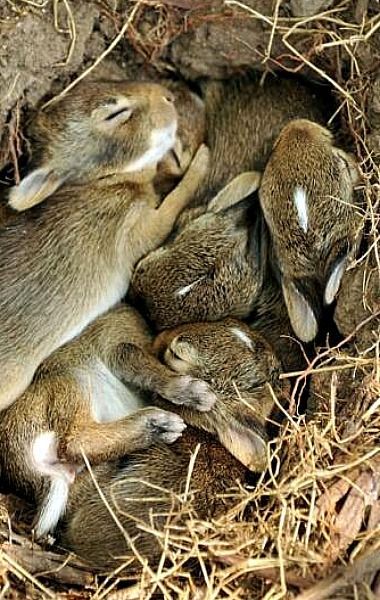 Use a cotton ball moistened with warm water and gently stroke the anal area until the bunny starts producing stool and urine and keep stroking until the bunny stops. You are reproducing the behavior of the mother rabbit who would lick her young to stimulate them to go to the bathroom and to keep the nest clean.
Use a cotton ball moistened with warm water and gently stroke the anal area until the bunny starts producing stool and urine and keep stroking until the bunny stops. You are reproducing the behavior of the mother rabbit who would lick her young to stimulate them to go to the bathroom and to keep the nest clean.
Provide a soft nest area in a box with clean towels, and cover the babies so it is dark until their eyes are open. Do NOT provide extra heat if the room temperature is at least 65 to 70 degrees F because excessive heat can be fatal. If the room is cooler, then you may place a heating pad on a low setting under no more than HALF of the nest so the bunny can move to a cooler area if it gets too warm, and be sure there is no way the mother rabbit can get to or chew the electrical cord!
For domestic rabbits, if you have a healthy adult rabbit at home and you can collect cecotropes (the soft, chain-like droppings that the rabbit usually eats) then these can be mixed with the KMR to give the baby bunny normal bacteria for its intestinal tract. Only one cecotrope per day for 4-5 days is needed. This is particularly important for rabbits under one week of age. Also good is to sprinkle a pinch of acidophilus powder, also called “Probiotic” from human capsules in the milk a little each time for healthy flora for both wild and domestic bunnies.
Only one cecotrope per day for 4-5 days is needed. This is particularly important for rabbits under one week of age. Also good is to sprinkle a pinch of acidophilus powder, also called “Probiotic” from human capsules in the milk a little each time for healthy flora for both wild and domestic bunnies.
As soon as their eyes are open, you may introduce the bunnies to plain alfalfa pellets, hay, such as oat hay, timothy, alfalfa. Please refer to the handout Care of Rabbits for more information on diet for domestic, pet rabbits. You may reach [email protected] for domestic/pet rabbit questions. Below is the email for wild rabbit questions: [email protected] (wild) (If links above did not answer your question).
(See above for wild rabbits). For all rabbits, avoid ANY regular milk, puppy formulas, etc. Use KITTEN formulas like KMR. Avoid Esbilac. Feed only upright. Less is better than more! Overfeeding will cause bloat and pain and possible death. Please get to a rehabber.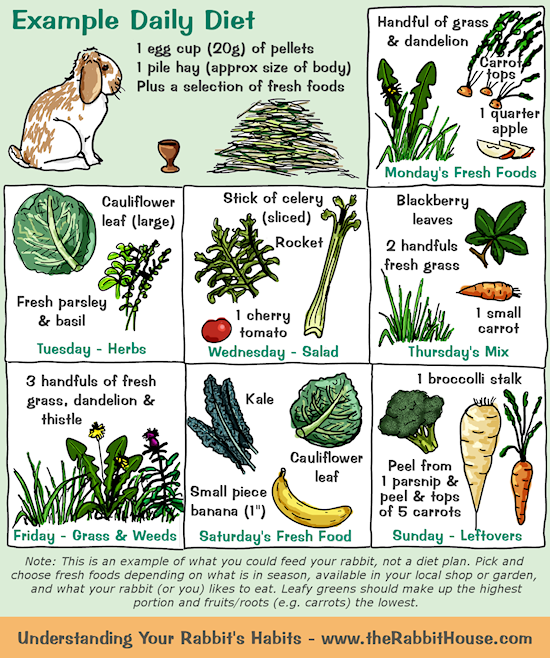
Sources: Caring for Cricket – What Not To Do When You Find a Wild Baby Bunny by Julie Smith and Handout by Midwest Exotic Animal Hospital, and additional wild bunny info by M. Wilson (HRS educator and rehabber). For questions not answered about wild rabbits above, email: wildbunnyrehab at gmail.com
Below content was merged from: /caring-for-orphans/
Rabbit mothers nurse their babies for approximately 5 minutes a day. They will be in the nest or nest box early in the morning and then again in the evening. The milk is very rich and the babies “fill up” to capacity within minutes. Mother rabbits do not “sit” on the babies to keep them warm as do some mammals and birds. They build a nest with fur and grasses which helps to keep the babies warm in between feedings. Do not force a mother rabbit to sit in the nest box. You can pick up the babies and see if they are feeding by checking the size of their stomachs (should not be sunken in), the pinkness of their skin and activity level (they should not be blue in color or sluggish in movement) and the amount of time that you hear them crying (baby bunnies should be quiet most of the day…. if they are crying constantly then they are not getting fed). If they are warm, mom is most likely feeding them, but again, she only comes back in the middle of the night.
if they are crying constantly then they are not getting fed). If they are warm, mom is most likely feeding them, but again, she only comes back in the middle of the night.
If you come across a nest of bunnies in the wild and the mother is no where to be seen, please DO NOT disturb them…this is normal. By removing them from the nest you are greatly reducing their chances of survival.In the rare situation that you have an orphaned bunny, such as when a mother rabbit is killed by another animal or in the road, or when a domestic rabbit refuses to care for her young, you may try feeding with Kitten Milk Replacer (KMR) or Meyenberg Goat Milk (for wild rabbits, but they need a professional reahabber–do not feed at home). Remember though, that both wild/domestic bunny moms only feed in the middle of the night, so don’t assume she is not caring for them! For true orphans, remember to feed ONLY TWICE A DAY. Overfeeding is a leading cause of death in these youngsters which results in fatal intestinal disease. Provide a soft nest area in a box with clean towels, and cover the babies (if eyes are closed) so it is dark.
Provide a soft nest area in a box with clean towels, and cover the babies (if eyes are closed) so it is dark.
DO NOT provide extra heat if the room temperature is at least 65 to 70F because excessive heat can be fatal. If the room is much cooler, then you may place a heating pad on a low setting under no more than HALF of the nest so the bunny can move to a cooler area if it gets too warm.
For a wild bunny, you need to get him to a wildlife rehabilitator if he is TRULY orphaned (mom was killed). Remember with wild bunnies, the mom ONLY comes back at night to call and feed him; please put him back for her if just found and healthy. With domestics, the mom only feeds once or twice a day for only 5 minutes. Leave babies with the mom. For wild orphans, first google your state and wildlife rehabber, and call your humane society, also try http://www.humanesociety.org/animals/resources/tips/find-a-wildlife-rehabilitator.html and http://www.owra.org/find-a-wildlife-rehabilitatoror as it is illegal in most states to keep a wild animal, and they really need a professional as this is critical.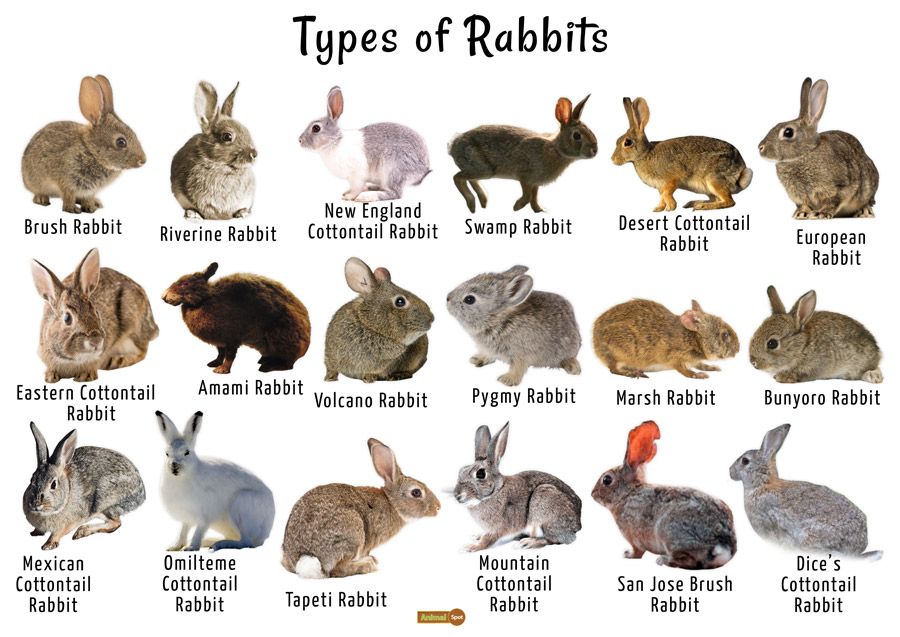 Local rabbit veterinarians or humane societies may also know of a rehab facility.
Local rabbit veterinarians or humane societies may also know of a rehab facility.
The following is a guideline for the daily amount to feed a TRULY orphaned bunny (mother was killed, etc.) that will be about 5 lbs as an adult. It is impossible on the internet to be exact. Please find rehabber.
GENERAL FEEDING OF ORPHANS
Age + Amount (This WILL vary depending on type of rabbit.) Use KMR (Kitten Milk Replacer) for domestics and Meyenberg Goat Milk, regular not low fat for wild ones,or KMR. Add a pinch of acidophilus (AKA Probiotic capsules) to all formula to promote healthy gut flora. Other formulas vary depending on the region of the country. Avoid using Esbilac or any puppy formulas or cow’s milk. Do not add Karo syrup. FEED TWICE A DAY ONLY unless baby is low weight, than three times.
Newborn to One Week: 2 – 2+1/2 cc/ml each feeding (two feedings).
1-2 weeks: 5-7 cc/ml each feeding (two feedings).
(depending on bunny. .may be much LESS if smaller rabbit).
.may be much LESS if smaller rabbit).
2-3 weeks: 7-13 cc/ml each feeding (two feedings). Bunnies whose eyes are still CLOSED need to be stimulated to urinate and defecate before or after each feeding. Again, seek a professional on this. Domestic eyes open at about 10 days of age. Then start introducing them to timothy and oat hay, pellets and water (always add fresh greens for wild ones–dandelion greens, parsley, carrot tops, grated carrots, all fresh, watered down). See below for detail.
3-6 weeks: 13-15 cc/ml each feeding (two feedings–again, may be LESS depending on size of rabbit! A cottontail will take so much LESS–about half of this!.)
Domestics are weaned about 6 weeks. Cottontails wean and release about 3-4 weeks and jackrabbits much later (9+ weeks). Feed only twice a day up to these TOTAL amounts. You may find an eyedropper or syringe easiest to use. Feed them upright, and go slowly watching them lick and swallow so they do not aspirate. For domestic rabbits, if you have a healthy adult rabbit at home and you can collect cecotropes (the soft chain-like droppings that the rabbit usually eats) then these can be mixed with the KMR or goat milk to give the baby bunny normal bacteria for its intestinal tract. Only one cecotrope per day for 4-5 days is needed. This is particularly important for rabbits under one week of age. Acidophilus capsules for humans, opened and sprinkled some in formula, works well too.
For domestic rabbits, if you have a healthy adult rabbit at home and you can collect cecotropes (the soft chain-like droppings that the rabbit usually eats) then these can be mixed with the KMR or goat milk to give the baby bunny normal bacteria for its intestinal tract. Only one cecotrope per day for 4-5 days is needed. This is particularly important for rabbits under one week of age. Acidophilus capsules for humans, opened and sprinkled some in formula, works well too.
After each feeding it is important to make the bunny defecate and urinate (until their eyes are open) to keep the intestinal tract and urinary system running smoothly. Use a cotton ball moistened with warm water and gently stroke the anal area until the bunny starts producing stool and urine and keep stroking until the bunny stops. You are reproducing the behavior of the mother rabbit who would lick her young to stimulate them to go to the bathroom and to keep the nest clean. No need to do this for jackrabbits or if bunny’s eyes are open.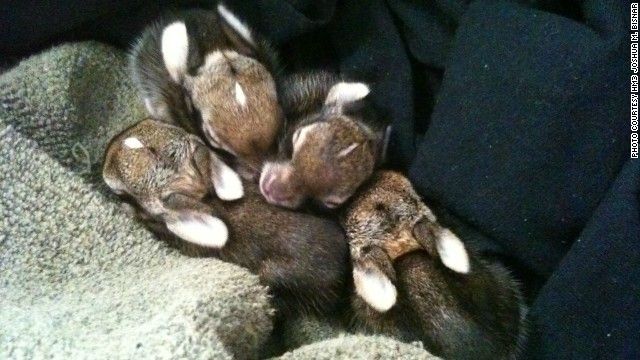
As soon as their eyes are open, you may introduce the bunnies to hay, such as oat and timothy hay, some alfalfa, and pellets, and for wild ones, add dark leafy veggies such as dandelion greens, carrot tops, parsley, grated carrots, etc. Keep the greens fresh, moist, and stand them up in a heavy mug of water. Change greens often. If this is a wild rabbit, you do not need to introduce pellets. If this is a domestic rabbit baby, then you may introduce plain alfalfa pellets at 2 weeks of age (please refer to the handout Care of Rabbits for more information on diet). Wild rabbits should be released as soon as they are eating hay and greens and are approximately 5 inches in body length (for cottontails) and are afraid of you (about 3-4 weeks). Jackrabbits are released much later (9 weeks up). They will be small, but the longer you keep them, the more agitated and difficult to handle they will become, and the less likely their chances for survival in the wild. They may be easily injured in your care as they attempt to get free. For wild bunnies, please do not raise them yourself, but take them to a rehabber! Google your state and wildlife rehabber or see links above.
For wild bunnies, please do not raise them yourself, but take them to a rehabber! Google your state and wildlife rehabber or see links above.
Modified from an original document from :
Midwest Bird & Exotic Animal Hospital
How to feed baby rabbits without a female rabbit from the first days of life
From time to time, farmers have to face the problem of how to feed baby rabbits without a female rabbit. The reasons for the need may be different, but the solution is always equally necessary. In this position, the efficiency and fidelity of actions directly affect the survival of babies. Any mistake can lead to the death of the offspring in just a few hours.
How to feed baby rabbits without a female rabbit
Contents of Article
- 1 Is it possible to feed baby rabbits without a female rabbit?
- 2 What can replace rabbit milk?
- 3 Rules for feeding
- 4 Artificial feeding rabbits by age
- 4.1 from birth to 5 days
- 4.
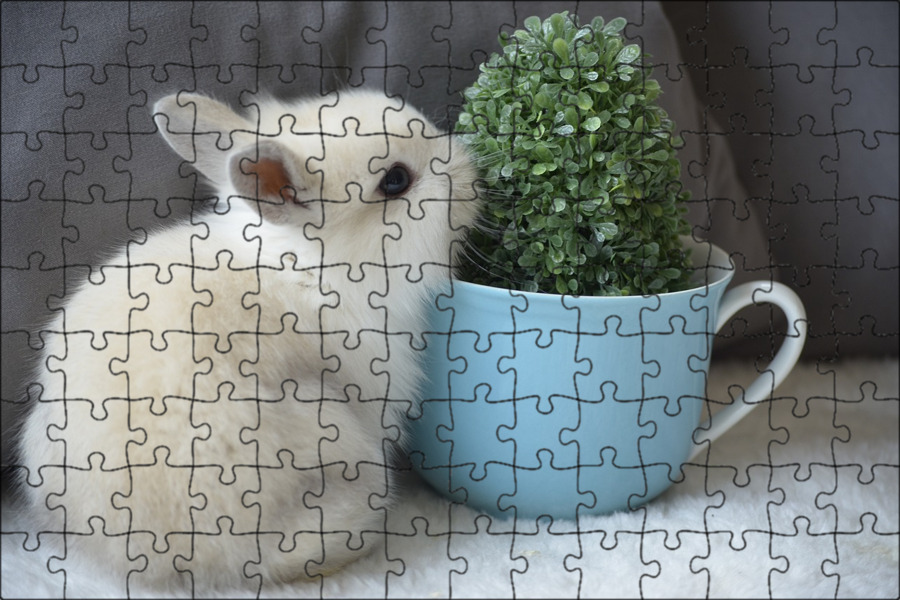 2 from 6 to 14 days
2 from 6 to 14 days - 4.3 Video - how to feed a rabbit through a syringe
- 4.4 from 15 to 30 days
- 5 What to feed baby rabbits per month?
- 5.1 Prices for rabbit feed
- 6 Feeding
- 7 Advantages and disadvantages of artificial feeding of young animals
- 8 Care of young rabbits during artificial feeding
- 8.1 Prices for cages for rabbits
Is it possible to feed rabbits without a female rabbit?
It is possible to feed offspring of rabbits without a female, although the process will require a waste of time and money. The organization of such a meal obliges you to purchase some accessories, follow schedules, be with the kids a lot. The main difficulties occur in the first weeks of the life of rabbits. As they grow older, the need for constant support disappears, the animals become independent. nine0003
Babies with a rabbit
Artificial feeding is considered undesirable unless absolutely necessary. Wrong actions can reduce the percentage of survival. Third-party nutrition, human care will not completely replace mother's milk and care. Meanwhile, there are cases when orphaned babies grew up stronger, thanks to the hard work of breeders.
Wrong actions can reduce the percentage of survival. Third-party nutrition, human care will not completely replace mother's milk and care. Meanwhile, there are cases when orphaned babies grew up stronger, thanks to the hard work of breeders.
Newborn rabbit
Procedure required for certain problems:
- female death . Sometimes the rabbit dies during or after childbirth. It is very difficult to predict the sad outcome;
- atrophied parental instinct . Often occurs in the first litter in young individuals. The newly-made mother does not want to feed her offspring. In most cases, the instinct can be awakened forcibly by holding the female several times in the process of feeding the babies. However, there are times when no tricks help;
- passion for hunting . Restless rabbits can abandon children within a day after giving birth. They begin to run around the living space, furiously looking for food.
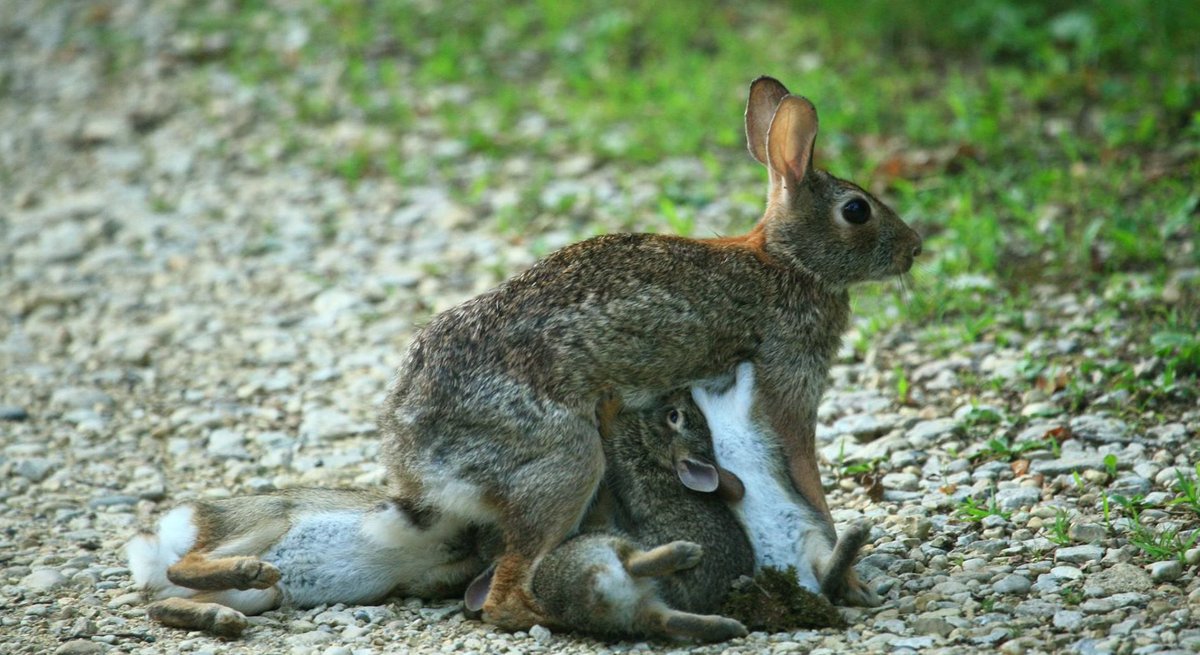 In such impulses, rabbits often die from accidental trampling by their own mother. The problem is solved by provocation. Mating is carried out with a male incapable of conception. After that, the female can calm down. If the attempt is unsuccessful, artificial feeding cannot be avoided;
In such impulses, rabbits often die from accidental trampling by their own mother. The problem is solved by provocation. Mating is carried out with a male incapable of conception. After that, the female can calm down. If the attempt is unsuccessful, artificial feeding cannot be avoided; - sore nipples . It is also more common in young rabbits. Roughened skin does not allow milk to pass quietly, the process causes severe inconvenience to the mother and she stops letting offspring; nine0010
- strong odors . Rabbits are sensitive to foreign odors. The most unpleasant for them are shades of alcohol, perfume, household and technical liquids. Sometimes the smells of other animals living in the neighborhood play a cruel joke. Discomfort leads to the damping of instincts.
Feeding of young rabbits by another mother
In these situations, if possible, try placing the babies on another mother. However, not every rabbit will willingly accept someone else's offspring. In addition, a large number of babies will lead to exhaustion of the female. Therefore, experienced farmers prefer to immediately get down to business on their own. nine0003
In addition, a large number of babies will lead to exhaustion of the female. Therefore, experienced farmers prefer to immediately get down to business on their own. nine0003
See also: The rabbit does not feed the rabbits: what to do?
It happens that the rabbit refuses to feed newborns. Everyone who breeds rabbits should know what to do in such a situation. Why the rabbit does not feed the rabbits and how to deal with the problem, we will tell in the article.
What can replace rabbit milk?
Newborn rabbits are recommended to be fed with quality substitutes. This is the only way they can get the maximum amount of nutrients. Valid options are:
As for cow's milk, opinions differ. Some farmers consider it categorically unacceptable for rabbits. Other breeders claim that such a substitution is possible when there are no other options. Cow's milk differs significantly from rabbit's in composition, fat content, and ability to be digested.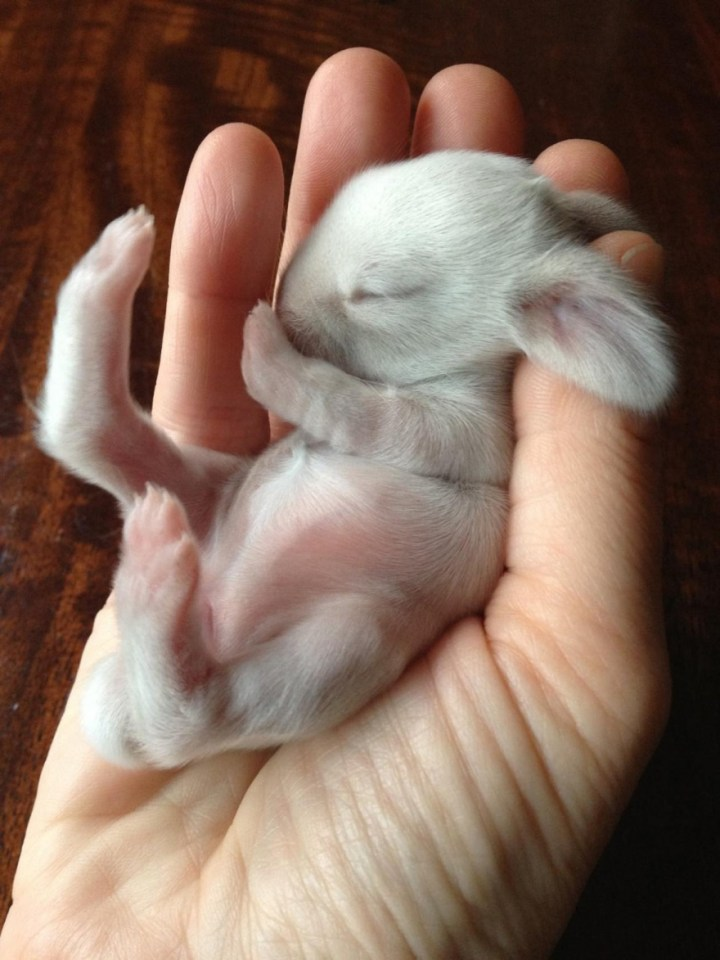 In its pure form, it does not satisfy the needs of small rabbits. Some sources suggest mixing whole cow's milk with condensed milk (preferably without sugar) 4 to 1. But this mix is classified as emergency. nine0003
In its pure form, it does not satisfy the needs of small rabbits. Some sources suggest mixing whole cow's milk with condensed milk (preferably without sugar) 4 to 1. But this mix is classified as emergency. nine0003
Cow's milk can be used when there are no other options
Rules for feeding
Rabbits are born blind, without hair on the body, weighing about 60 g. Without the ability to see and move freely, nutritional skills are absent. Babies are completely defenseless, so the loss of a nursing mother is a very dangerous phenomenon for them. A person must perform the functions of a rabbit. You will need to master certain skills, acquire inventory. nine0003
Newborn rabbits
In the first days of life, babies need a nipple. It can be played by:
- large pipette;
- 20 ml syringe without needle;
- clean bottle of eye drops;
- small size baby bottle;
- special kit for animal feeding.
Feeding set 1
Syringe and drop bottle have been improved by craftsmen for easy feeding. The rubber cap from the pipette is put on the spout of the selected container. Previously, several punctures are made in the rubber. In store kits there is a special syringe and tips of different sizes. As the rabbits grow, the devices can be changed, moving from a pipette to a bottle. From day 20, most babies begin to eat from a saucer on their own. nine0003
The rubber cap from the pipette is put on the spout of the selected container. Previously, several punctures are made in the rubber. In store kits there is a special syringe and tips of different sizes. As the rabbits grow, the devices can be changed, moving from a pipette to a bottle. From day 20, most babies begin to eat from a saucer on their own. nine0003
Feeding set 2
Feeding should be built as close to natural flow as possible. The more accurately the details are copied, the faster the animals will acquire instincts. Until the eyes open, newborns show little reaction to the artificial nipple. Milk has to be poured into the mouth. It is important to squeeze out the liquid gradually so that the baby does not choke. The first 2-3 days it is better to start feeding by smearing milk around the mouth. The rabbit will lick it himself. For inactive individuals, the procedure is repeated several times. If the rabbit perks up when he feels the taste of food, you can already proceed to the infusion of a few drops.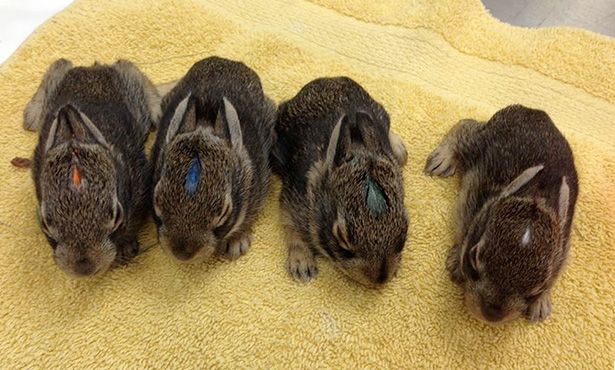 nine0003
nine0003
Feeding should be built as close as possible to the natural flow
A blind baby can eat no more than 1 ml of milk at a time. The stomach should not be full. Overfeeding threatens with gastric disorders, inflammation of the respiratory system. The rabbit must be held vertically in the hand, without squeezing the body. The liquid is stored in the refrigerator for no more than 72 hours, heated before the procedure to 37-38°C. The mixture is always prepared fresh.
Keep baby upright
The easiest way to determine the optimal feeding times is to observe the behavior of the young. Well-fed cubs behave calmly, quietly, sleep a lot. In a hungry state, they become restless, try to move around in search of a mother and squeak.
Artificial feeding of rabbits according to age
Each age of rabbits requires its own feeding schedule. The frequency is adjusted according to the speed of digestion of food. Appetite increases with the growing body. By the end of the first week, babies are already able to overeat, so following the rules is necessary for their health.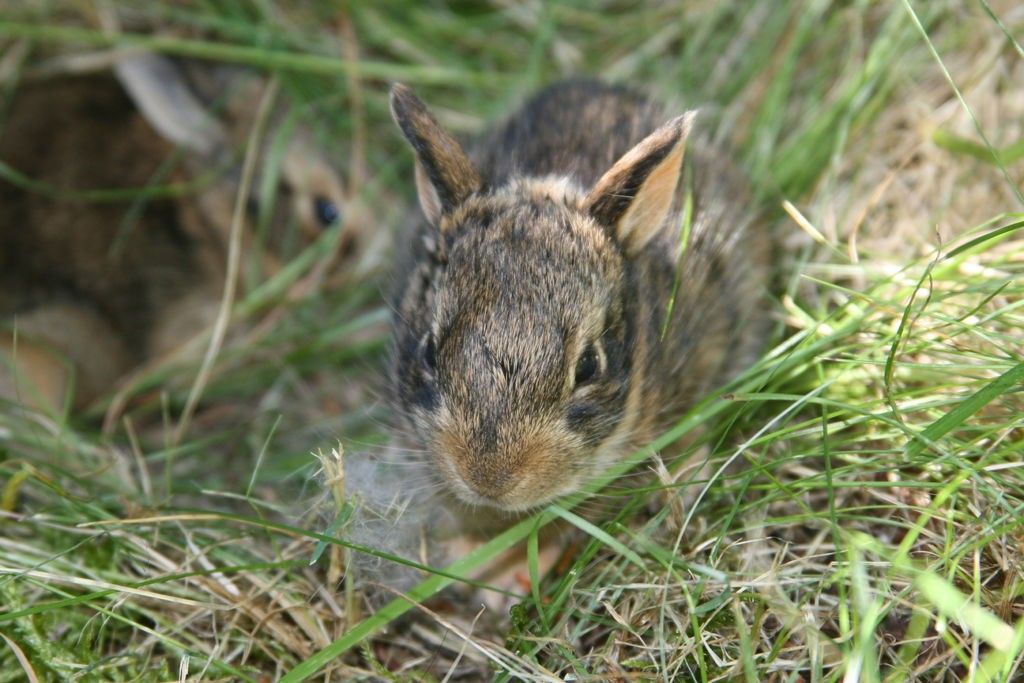 Until the 30th day, the diet consists only of milk. nine0003
Until the 30th day, the diet consists only of milk. nine0003
Up to a month, only milk is included in the diet
From birth to 5 days
A newly born rabbit is given literally 1 drop of liquid. During the day, the number of drops is increased gradually in 5-6 visits. The animal does not yet have a good swallowing reflex, so special care is needed. From the second day it is enough to feed 4-5 times. By the end of the period, the baby should double its birth weight (120-180 g for different breeds). On the fifth day, food is given 4 times.
Pipetting
Days 6 to 14
From day 6, young rabbits are fed three times a day. This mode lasts up to 2 weeks of life. During this time, the weight of the babies reaches 200-260 g. Portions gradually grow along with the animals.
Syringe nipple
Video - How to feed a rabbit through a syringe
From 15 to 30 days
Days 15 and 16, individuals are transferred to a two-time diet. They observe their behavior, if there is not enough food, add a little mixture in the form of a third feeding. From the 17th day onwards, portions become impressive, the body prepares for the adult regimen, so two feedings do not exceed. By day 30, the rabbits weigh about 500 g. Depending on the breed, the weight may be slightly less or more. Weaning from the nipple begins by the end of the third week. Early maturing species are often ready for the introduction of other products already on the 20-25th day. Readiness can be tracked by the behavior and condition of the teeth. When milk teeth are almost completely replaced by molars, interest in solid food wakes up, the animal is transferred to a new food. nine0003
They observe their behavior, if there is not enough food, add a little mixture in the form of a third feeding. From the 17th day onwards, portions become impressive, the body prepares for the adult regimen, so two feedings do not exceed. By day 30, the rabbits weigh about 500 g. Depending on the breed, the weight may be slightly less or more. Weaning from the nipple begins by the end of the third week. Early maturing species are often ready for the introduction of other products already on the 20-25th day. Readiness can be tracked by the behavior and condition of the teeth. When milk teeth are almost completely replaced by molars, interest in solid food wakes up, the animal is transferred to a new food. nine0003
Baby bunny drinking milk from a bottle
Increase the amount of milk as it grows. The larger the breed, the larger the single serving.
| Feeding rate per 1 individual per day (for 1 feeding) | |
|---|---|
| 1-7 days | 5 ml (1 ml) |
| 8-14 days | 20 ml (5 ml) |
| 15-20 days | 20-26 ml (10-13 ml) |
| 21-30 days | 30-50 ml (15-25 ml) |
What to feed baby rabbits per month?
When the rabbits gain strength, the teeth will get stronger, they begin to connect solid food. Some farmers completely exclude milk by 31 days. Others prefer to keep it as a supplement in small amounts. Experts recommend leaving dairy food only with weight loss.
Some farmers completely exclude milk by 31 days. Others prefer to keep it as a supplement in small amounts. Experts recommend leaving dairy food only with weight loss.
Hay is added to the diet
New food is offered to rabbits from 3 weeks of age. Even during the period of milk nutrition, small heaps of hay are placed on them. It is important to observe the baby's stool. The slightest signs of diarrhea serve as a stop signal for feeding. Disorders of the gastrointestinal tract for these animals are very dangerous, since digestion after them may not recover. If the introduction was successful, gradually add small grass, a few granules of compound feed, a pinch of grated carrots. So the transition to adult food is as smooth as possible. nine0003
Feed prices for rabbits
Feed for rabbits
The intestines of a monthly rabbit are able to digest food without stagnation. The basis of the diet is now made up of granular mixtures, greens and hay, oatmeal flakes, vegetables, root crops. All food must be fresh.
All food must be fresh.
Babies start eating on their own
Granules include the necessary vitamin premixes. Their size varies, so a serving per individual is considered 3% of the individual's weight. Carrots, cabbage leaves are crushed at first, then they begin to be given in large pieces. Beets, potatoes, turnips are given only for fodder, not more than 1-2 times a week. Dry food must be moistened, otherwise they irritate the respiratory tract of rabbits. Animals should always have access to clean drinking water. nine0003
Monthly rabbit food pyramid
Always leave only hay and water in the feeding area. The rest of the food is laid according to the regimen, the remains are removed daily.
| Rabbit feeding norms from 1 month. Gram per day for 1 individual | |
|---|---|
| Concentrated granules | 40-60 g |
| Hay | 120-150 g |
| Grass | 300-500 g |
| Vegetables, root crops | 150-200 g |
In winter, the norms are calculated according to the upper permissible limit. In summer, the amount of grass is increased, and the granular feed is reduced to a minimum.
In summer, the amount of grass is increased, and the granular feed is reduced to a minimum.
Granular food
It is forbidden to feed baby rabbits with sprouted potatoes, wild herbs, branches of unknown trees. Many breeds are poisonous to these animals; it is necessary to study acceptable plants in advance. Food with mold, rot, dirt, fungus, frozen areas can also cause irreparable harm to the pet's body. nine0003
See also: What not to feed rabbits
In this article, you can get acquainted with prohibited foods for rabbits, as well as what food will keep their health in order.
Feeding
The milk of a healthy rabbit can provide the offspring with all the necessary vitamins. On artificial feeding, newborn animals need help in the form of feeding. Ready mix substitutes often already contain premixes. In their absence, special preparations are added to natural milk on their own:
Premixes may also be present in pelleted feed. From day 31, you need to make sure that the total amount of top dressing is within the acceptable range.
From day 31, you need to make sure that the total amount of top dressing is within the acceptable range.
Experienced zookeepers recommend giving the following mix during the change of feed:
- 4 parts hay or grass meal;
- 3 parts barley;
- 2 parts peas or corn;
- 2 parts sunflower meal;
- 1 part wheat bran.
Homemade dressing
All ingredients are ground into coarse flour and given a pinch from the 20th day. From day 31, all or part of the pelleted feed can be replaced with this mixture.
Advantages and disadvantages of artificial feeding of young animals
Artificial feeding is always a last resort when raising offspring. The main disadvantage of this approach is the inability to give the kids the whole set of necessary trace elements. All substitutes remain only close to rabbit milk. A product from other animals, mixtures, one way or another, remain unbalanced specifically for rabbits. nine0003
nine0003
Baby rabbits get all the nutrients they need when fed naturally. This process often causes difficulties, slows down the formation of the swallowing reflex. In addition, there is a risk of making incorrect actions and harming the animal, and getting a substitute for native milk can be problematic and expensive. Another disadvantage is the need for a person to be present almost all day.
Plus of artificial feeding - unpretentiousness of rabbits in terms of nutrition
The main advantage of artificial feeding is the unpretentiousness of rabbits in terms of nutrition. Such animals quickly get used to new products, do not refuse top dressing because of the unusual taste, and have a good appetite. It is also easier to develop the habit of feeding on a schedule, to regulate the content of vitamins for individual ears.
Care of artificially fed rabbits
Immunity in artificially fed rabbits develops much more slowly than in offspring growing on mother's milk. In connection with this fact, increased requirements are imposed on the maintenance of babies. Main criteria to pay attention to:
In connection with this fact, increased requirements are imposed on the maintenance of babies. Main criteria to pay attention to:
- light . You will need to equip a cage or box with a darkened corner. The young in nature sleep in the shade of the mother, so the offspring will look for a place to hide. At night, the lights must be turned off. During the day, the lighting should be somewhat remote from the "dwelling", muffled. Keeping under the open sun or direct rays of the lamp is unacceptable;
Blackout box for rabbits
Prices for rabbit cages
Rabbit cage
Like this article? Save so you don't lose!
How and how to feed rabbits without a rabbit: useful tips and videos artificial feeding of rabbits. Today we will try to understand how it is possible to feed rabbits without a rabbit.
Contents:
- 1
Is it possible to artificially feed baby rabbits?
- 2
How to replace breast milk
- 2.
 1
1 Milk
- 2.2
Kozie milk
- 2.3
mixtures
9000 "Artificial feeding of rabbits and massage of the abdomen" - 2.
Is it possible to artificially feed baby rabbits?
How to feed baby rabbits without a female rabbit? First of all, let's talk about why situations like this arise. Most often, artificial feeding must be done if the mother refuses to feed her rabbits or dies for some reason. Let's take a closer look at the first reason. So, the rabbit does not feed the rabbits for a number of reasons, which include the following.
- Hunting offensive. It can start as early as the day after birth. Very often, females, if they are on the hunt, abandon their cubs, show concern, even rush around the cage, trampling small rabbits. The most effective method in such a situation is to cover the rabbit with an infertile male. This technique in rabbit breeding has its own name - a provocation. If, after mating, the negligent mother quickly calms down, then she will return to her duties, but if not, then the babies will have to find a new mother.
 You can get a lot of detailed tips by watching our video. nine0010
You can get a lot of detailed tips by watching our video. nine0010 - Hardened skin of the nipples. For some reason, it is observed in many young mothers. If there are pains that torment her during feeding, the female simply refuses her cubs. In such a situation, there is also a way out, you need to do the following: put the pets cleaned of fluff in a cage with another mother. This will allow the mother to recover, after which the babies can be safely returned to her.
- Odors. Another reason for refusal to feed may be the presence of foreign odors in the cage, such as technical fluids, alcohol, perfumes, other animals, industrial or household toxins. nine0010
- Lack of maternal instinct. Very often present in young animals. You can help the mother if you do the following: force her to feed the rabbits several times. As a rule, after this, the instinct in mothers wakes up.
- The death of a rabbit. There are cases when the mother dies during or immediately after childbirth.
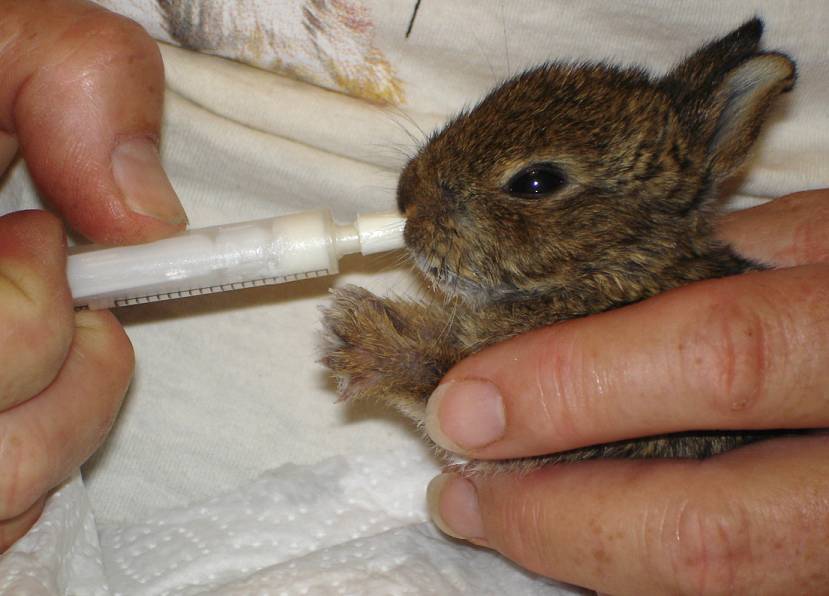 The remaining rabbits are best "give up" to another female for feeding. If there are none, then you will have to resort to artificial feeding. nine0010
The remaining rabbits are best "give up" to another female for feeding. If there are none, then you will have to resort to artificial feeding. nine0010
Avoid this technique whenever possible. The fact is that in any case, it is impossible to replace the beneficial properties that rabbit milk carries. In addition, artificial feeding cannot guarantee the survival of all offspring. A very important indicator here will be the age of orphaned children. Newborn rabbits are the most difficult to feed, but with a certain amount of effort and attention, this becomes possible. You can get a few other recommendations by watching our video. nine0003
How to replace mother's milk
All experienced rabbit breeders recommend feeding newborn or monthly rabbits with special mixtures or natural substitutes for rabbit milk, these include goat or cow milk. We will talk about each type of food separately.
Cow's milk
Most often, rabbit breeders resort to artificial feeding of babies with cow's milk.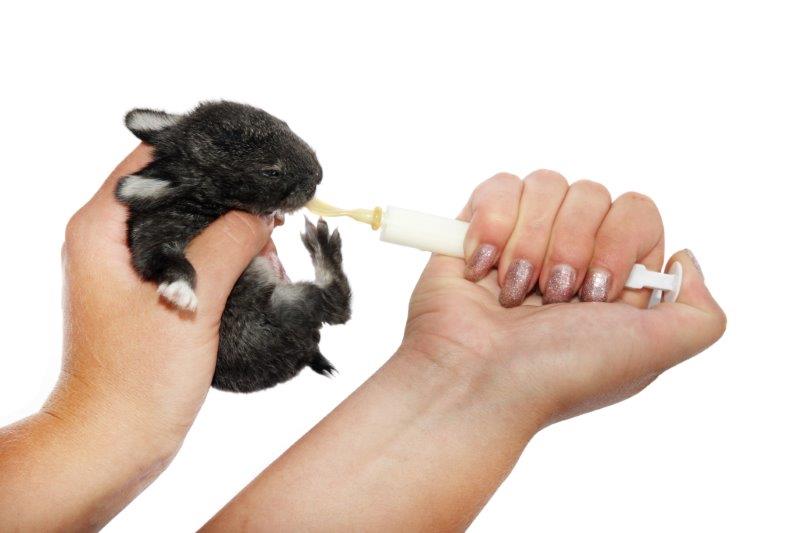 It is important to note that pure cow's milk is not suitable for monthly rabbits. Why is this so, you ask. The fact is that in its chemical composition it is too different from mother's milk. In order to feed pets, you need to make a special nutrient mixture, consisting of three quarters of whole milk and one quarter of condensed milk. Remember that this product must be heated at a temperature of 70 degrees for 30-60 minutes. After that, the mixture must be cooled to 37 degrees. You can get more recommendations by watching our video. nine0003
It is important to note that pure cow's milk is not suitable for monthly rabbits. Why is this so, you ask. The fact is that in its chemical composition it is too different from mother's milk. In order to feed pets, you need to make a special nutrient mixture, consisting of three quarters of whole milk and one quarter of condensed milk. Remember that this product must be heated at a temperature of 70 degrees for 30-60 minutes. After that, the mixture must be cooled to 37 degrees. You can get more recommendations by watching our video. nine0003
Goat's milk
In addition to cow's milk, goat's milk can also be used. It is very useful in its composition and is more fat. In addition, this type of dairy product does not need to be mixed with additional components, since its chemical composition is similar to rabbit milk.
Mixes
A very good option is artificial feeding of rabbits on dry milk mixtures. They are very nutritious and are well absorbed by small rabbits. It is worth remembering that this product must be made in a higher concentration than indicated in the corresponding instructions. When feeding a pet with a mixture, you need to take into account a certain feeding schedule. So, the required daily feeding schedule is shown in the table below. nine0003
It is worth remembering that this product must be made in a higher concentration than indicated in the corresponding instructions. When feeding a pet with a mixture, you need to take into account a certain feeding schedule. So, the required daily feeding schedule is shown in the table below. nine0003
| Age | Number | Sequence |
| 1-7 day | 5 ml | 3 times a day |
| 20 ml | 2 times a day | |
| 25-31 days | 60 ml | 2 times a day |
In addition, from the age of 17 days, pets should start to do special feeding and, if possible, give finely chopped vegetables. By the 45th day of life, rabbits refuse milk and any artificial mixtures. nine0003
Feeding procedure
Proper feeding of small pets is very important. How to feed rabbits without a rabbit? This is only possible if you follow the dosage and the order of feeding.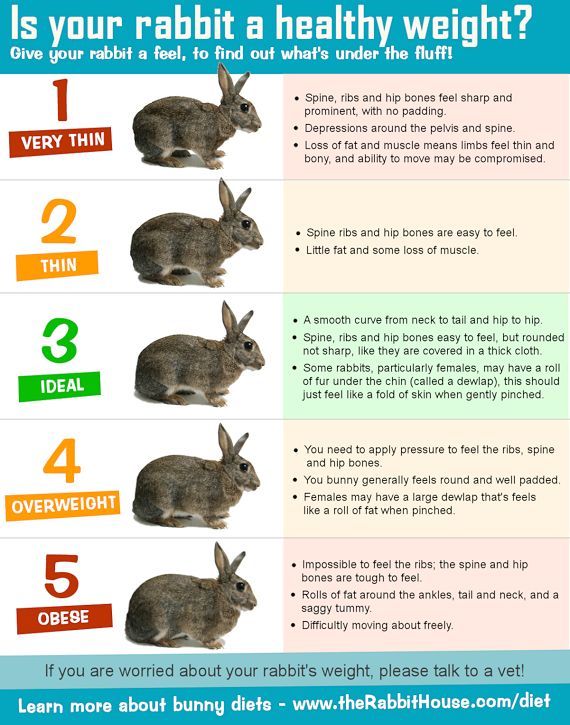
It is important to take into account the fact that it is necessary to provide artificial feeding of rabbits appropriate for their age. So, newborn babies should receive a very small amount of nutrition. The easiest way to feed is from a special syringe or pipette.
It is important to ensure that the bellies of the rabbits do not overflow. This is due to the fact that newborns do not yet have an understanding of "saturation", which means that they will eat as much food as you offer them. Keep an eye on your rabbits as they gain weight. So, newborn rabbits should weigh about 40-80 grams. You also need to monitor the regularity of the baby's stool. nine0003
It often happens that at the very beginning of feeding, rabbits refuse artificial udders. You can not press on the baby's oral cavity, forcibly introduce food to him, because it can easily get into the respiratory tract. The easiest way is to spread a little milk on the baby's mouth and wait until he licks off the food himself. The body of the newborn should be kept upright.
The body of the newborn should be kept upright.
Don't forget that babies don't have a bowel movement. Usually the mother who licks the belly of the babies helps in this, stimulating the work of the stomach. Therefore, before each feeding, you need to do the following procedure: with a damp soft cloth, run over the baby's tummy, pressing on the rabbit until it goes to the toilet. nine0003
You can get a lot of important tips from the Feeding Baby Bunnies video.
By 5 days after birth, rabbits should double their weight. At this point, begin to reduce the amount of food. The weight of babies for 5-14 days of life should already reach 250 grams. By the first month of life, helping pets is already much easier than newborns. By the first month, the animal should reach 500 grams. At this time, most of the teeth appear in pets, the animal begins to be interested in new food: vegetables, grass, hay, cereals and cereals.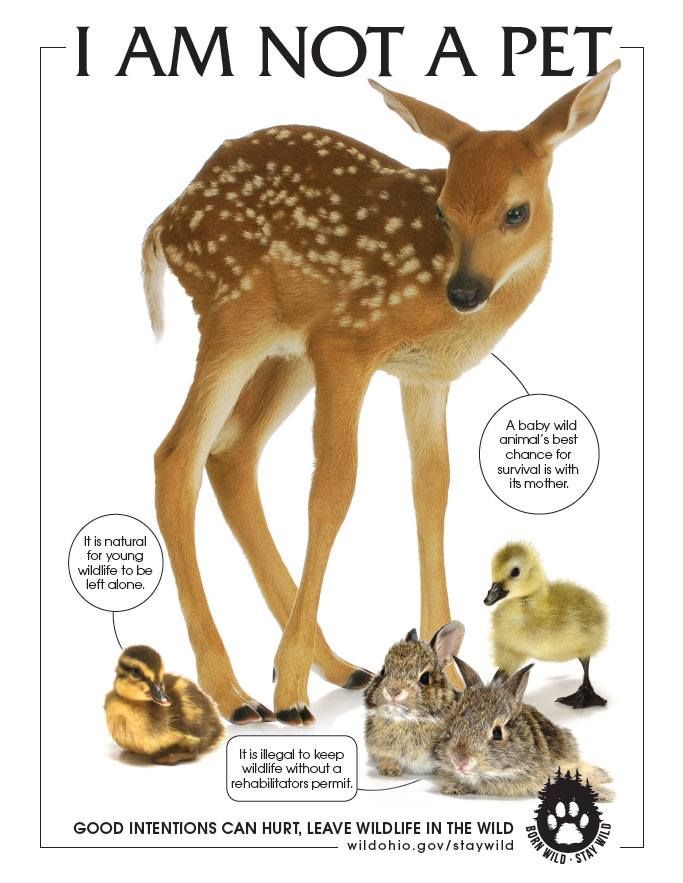 nine0003
nine0003
Feeding
Feeding should only be started when babies are 3 weeks old. Try to give small portions of hay, while continuing to parallel feeding with milk. It is worth remembering that at the slightest sign of diarrhea, you should immediately stop feeding. The fact is that diarrhea is a sentence for a rabbit. Their fragile stomachs simply cannot recover.
If the baby tolerated hay normally, you can add carrots to the diet. By the second month of life, babies can be transferred to eating grass, grain and water. nine0003
You can also give herbal pellets to babies. Doing this should start from 3 weeks of life of the cubs. The amount of this top dressing is calculated as 3% of the animal's weight.
In conclusion, I would like to say that it is very difficult for baby rabbits to go out. To do this, you need to show maximum attention and responsibility.
Video "Cattle Feeding Rabbits and Stomach Massage"
You can get some tips on how to feed and massage rabbits by watching our video.